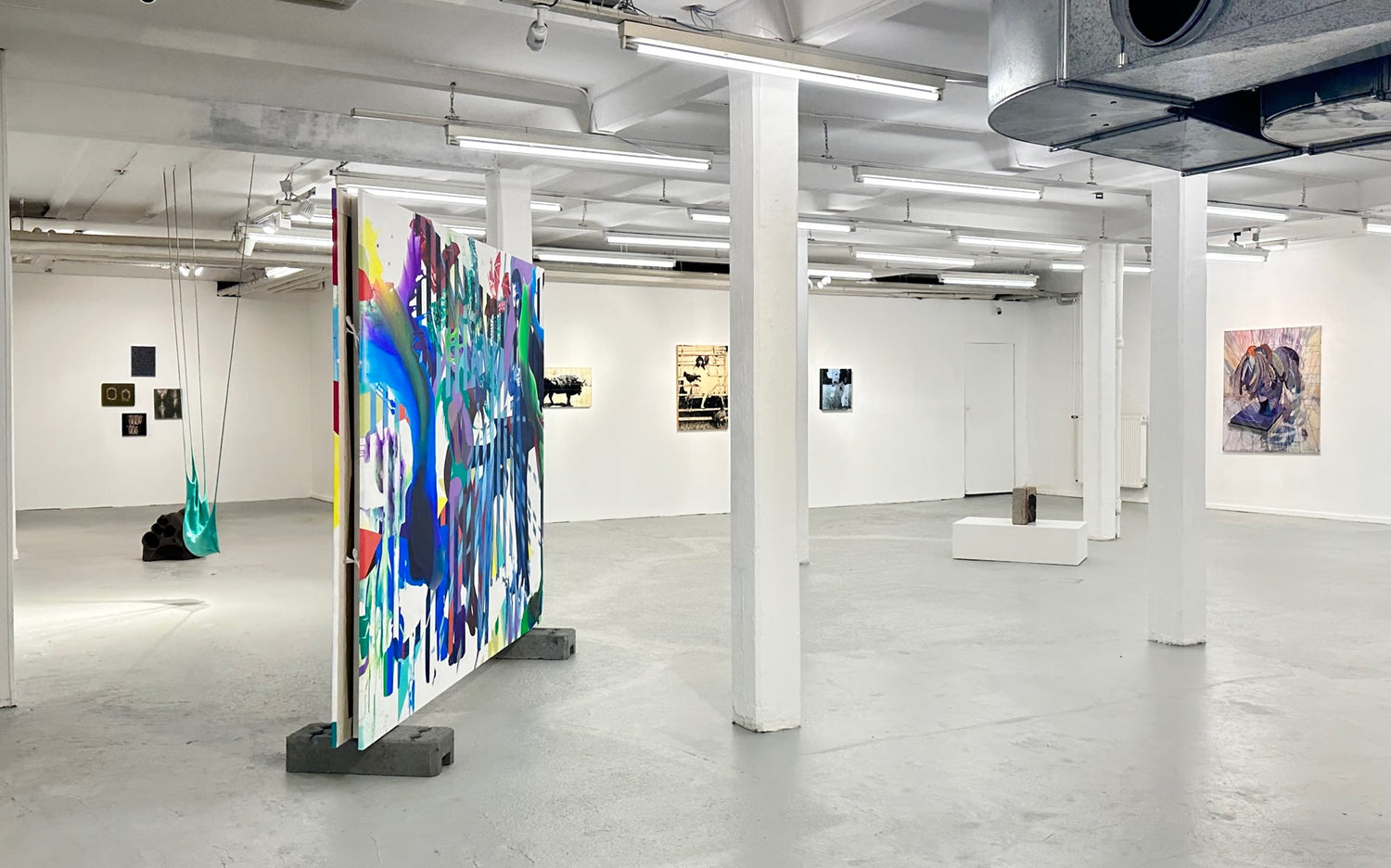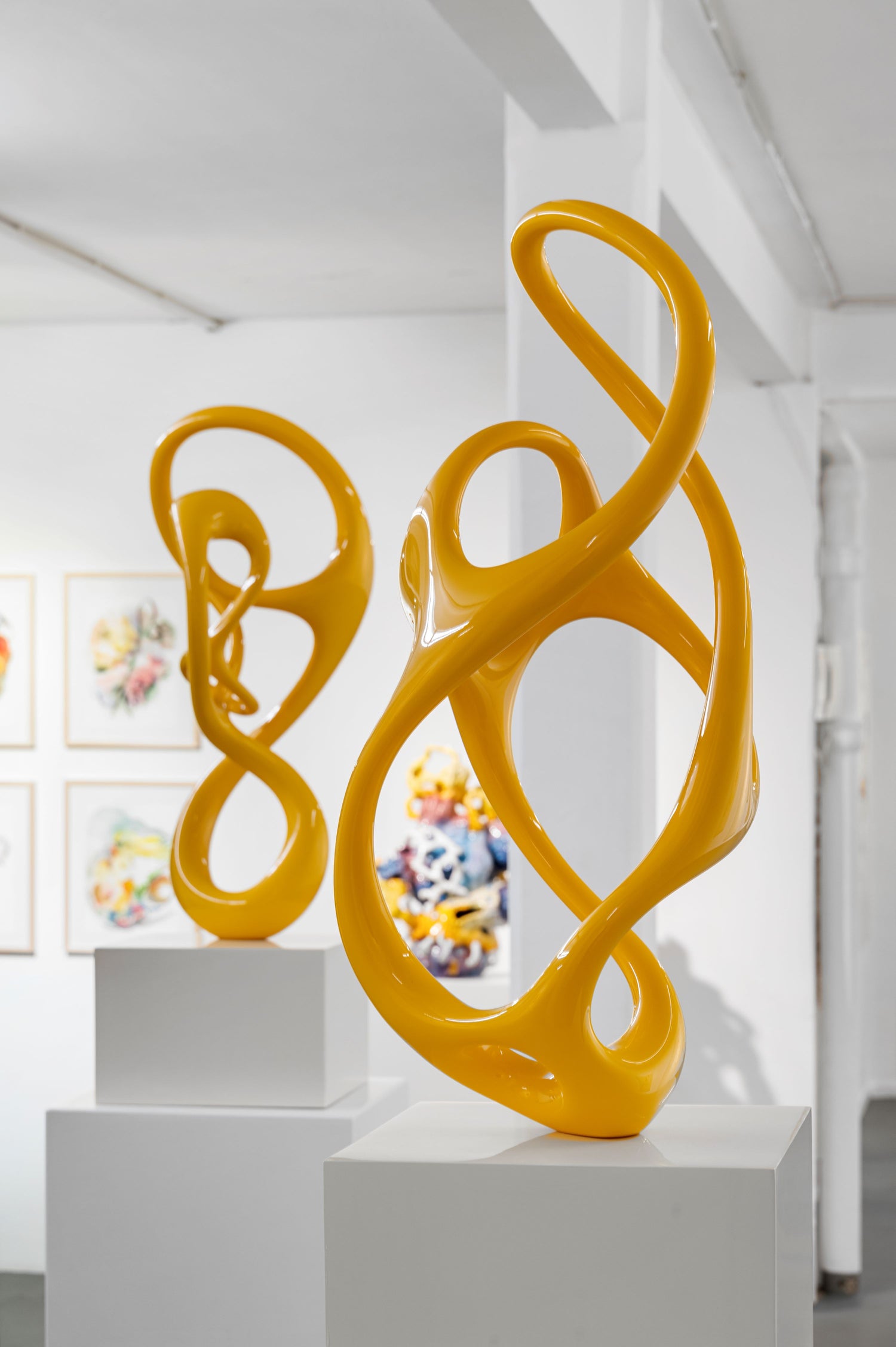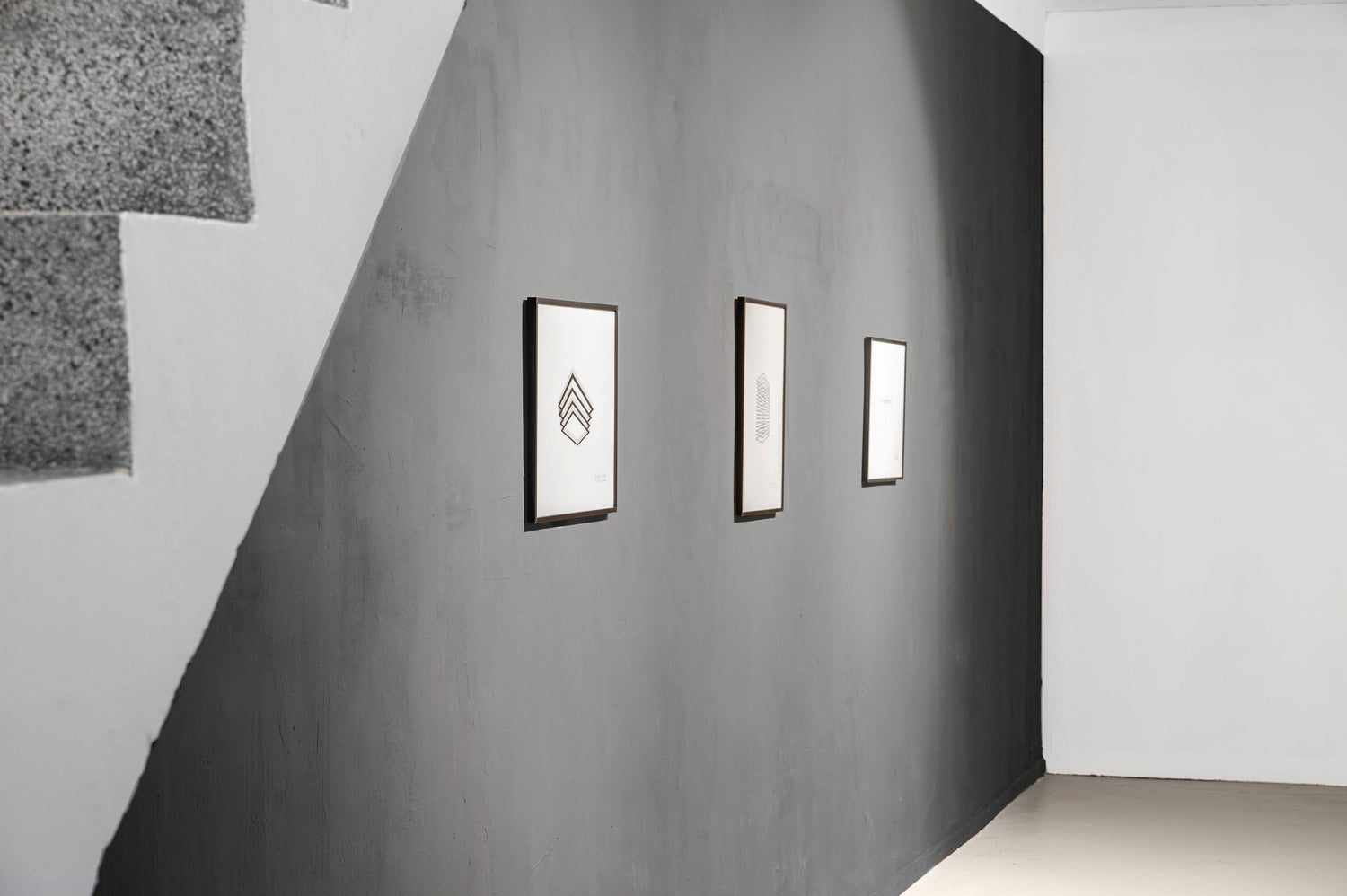Collection: Eric Andersen
A conversation with Erik Andersen...
...and the exhibition features objects, wall works and paintings by you. Can you say something basic about the way you work?
My way of working is as follows: I think about what I want to depict and in the second step I consider whether this idea is more suitable for an installation, a sculpture or a painting. Then, of course, come all the formal considerations: finding the right material, the format or the type of presentation. The work Handshake, for example, is intended to be touched in the exhibition. - You should touch them. I think that's why ceramic was a good choice. With the mask, the self-portrait, it was more of a content consideration. Some other epoxy resin jobs required wearing a protective mask during daily production. Since these works were objects that were lying around in a workshop, such as cable drums or saw blades, that I wanted to do something with, I had the idea of documenting this entire work situation with a self-portrait.
Does that mean your ideas for new work arise as a kind of logical consequence of previous work?
That is different. For example, during a long stay in the USA a few years ago, I was far away from all museums, galleries, my own studio, other artists and all the things that influence you. This made me think about the material that I use every day. The first canvas work was a turning point in my work. I liked the blank, dark canvas, but at the same time fully edited. The paradox of fullness and emptiness at the same time and the reference to painting itself. The canvas works are each an enlargement of the structure of a small section of canvas. They do not claim to be photorealistic. The first canvas is almost 9 m² in size, but is based on an approximately 20 cm large canvas section.
The same applies to corduroy work. The pixel structure is based on the surface texture of a small canvas work, a painted cable drum, which I then painted again in a much larger format.
The aspect of magnification also appears in your sculptures.
Yes... the handshake is about three times the size of the living cast I made at the beginning. This was necessary in order to be able to reach into them. I then used the traces of this first, rather rough impression when modeling the final shape.
In the work Self-Portrait, the negative shape of my face and the bands around the empty volume are exactly twice the size of the original. However, the more or less precise form is more of a necessity to refer to the content than an end in itself.
Is this also the case with Work Handshake? Since I know the work, I know that it is less an object to look at than to try out...
Yes, the openings on either side where you can shake hands are actually dead ends. You can't really touch each other's hands. The promise of this gesture is not fulfilled. I was concerned with the question of how we treat each other.
If you know the artist Gordon Matta Clark, you might find quotes from his work.
This is certainly the case in the work Cut. Gordon Matta Clark has completely cut through houses, I'm just simulating cutting through a wall. A wall that is cut through relatively close to the ground actually collapses and loses its security. This is the moment that interests me: what is supposedly safe becomes a factor of uncertainty.
The situation is very similar with the ladder made from extension cables. It actually makes you want to pull on it or climb it. But since the installation is only supported by two sockets on the ceiling, there is some hesitation. This fragile connection supports the weight of the work up to a height of perhaps seven or eight meters... This balancing act interests me as a metaphor.
I would like to know how you came up with the title Done, which you gave to a very small work where it is difficult to see anything.
Yes, similar to the wall work Daylight or the painting Atelier, Done refers to everyday life in the studio. What can now hardly be seen in the picture was once a realistically painted rag smeared with paint. Painting over is perhaps equivalent to taking away the rag, removing the traces of work. And yet in the end there is still something left over - at least the brush full of paint.
- Juliane Lachenmann and Erik Andersen,
Berlin, September 2014
...and the exhibition features objects, wall works and paintings by you. Can you say something basic about the way you work?
My way of working is as follows: I think about what I want to depict and in the second step I consider whether this idea is more suitable for an installation, a sculpture or a painting. Then, of course, come all the formal considerations: finding the right material, the format or the type of presentation. The work Handshake, for example, is intended to be touched in the exhibition. - You should touch them. I think that's why ceramic was a good choice. With the mask, the self-portrait, it was more of a content consideration. Some other epoxy resin jobs required wearing a protective mask during daily production. Since these works were objects that were lying around in a workshop, such as cable drums or saw blades, that I wanted to do something with, I had the idea of documenting this entire work situation with a self-portrait.
Does that mean your ideas for new work arise as a kind of logical consequence of previous work?
That is different. For example, during a long stay in the USA a few years ago, I was far away from all museums, galleries, my own studio, other artists and all the things that influence you. This made me think about the material that I use every day. The first canvas work was a turning point in my work. I liked the blank, dark canvas, but at the same time fully edited. The paradox of fullness and emptiness at the same time and the reference to painting itself. The canvas works are each an enlargement of the structure of a small section of canvas. They do not claim to be photorealistic. The first canvas is almost 9 m² in size, but is based on an approximately 20 cm large canvas section.
The same applies to corduroy work. The pixel structure is based on the surface texture of a small canvas work, a painted cable drum, which I then painted again in a much larger format.
The aspect of magnification also appears in your sculptures.
Yes... the handshake is about three times the size of the living cast I made at the beginning. This was necessary in order to be able to reach into them. I then used the traces of this first, rather rough impression when modeling the final shape.
In the work Self-Portrait, the negative shape of my face and the bands around the empty volume are exactly twice the size of the original. However, the more or less precise form is more of a necessity to refer to the content than an end in itself.
Is this also the case with Work Handshake? Since I know the work, I know that it is less an object to look at than to try out...
Yes, the openings on either side where you can shake hands are actually dead ends. You can't really touch each other's hands. The promise of this gesture is not fulfilled. I was concerned with the question of how we treat each other.
If you know the artist Gordon Matta Clark, you might find quotes from his work.
This is certainly the case in the work Cut. Gordon Matta Clark has completely cut through houses, I'm just simulating cutting through a wall. A wall that is cut through relatively close to the ground actually collapses and loses its security. This is the moment that interests me: what is supposedly safe becomes a factor of uncertainty.
The situation is very similar with the ladder made from extension cables. It actually makes you want to pull on it or climb it. But since the installation is only supported by two sockets on the ceiling, there is some hesitation. This fragile connection supports the weight of the work up to a height of perhaps seven or eight meters... This balancing act interests me as a metaphor.
I would like to know how you came up with the title Done, which you gave to a very small work where it is difficult to see anything.
Yes, similar to the wall work Daylight or the painting Atelier, Done refers to everyday life in the studio. What can now hardly be seen in the picture was once a realistically painted rag smeared with paint. Painting over is perhaps equivalent to taking away the rag, removing the traces of work. And yet in the end there is still something left over - at least the brush full of paint.
- Juliane Lachenmann and Erik Andersen,
Berlin, September 2014
-
Canvas | Erik Andersen
ArtistErik AndersenRegular price €6.900,00 EURRegular priceUnit price / per€9.000,00 EURSale price €6.900,00 EURSale -
Atelier | Erik Andersen
ArtistErik AndersenRegular price €2.000,00 EURRegular priceUnit price / per€3.200,00 EURSale price €2.000,00 EURSale -
Füsse 26.08.14 | Erik Andersen
ArtistErik AndersenRegular price €1.950,00 EURRegular priceUnit price / per€2.800,00 EURSale price €1.950,00 EURSale -
Füsse 28.08.14 | Erik Andersen
ArtistErik AndersenRegular price €1.950,00 EURRegular priceUnit price / per€2.800,00 EURSale price €1.950,00 EURSale
-

Affordable Art
Great art at small prices. Discover outstanding works by emerging artists as...













